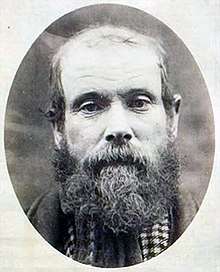Robert Francis Burns
Robert Francis Burns (c. 1840 – 25 September 1883) was an Irish Australian convicted murderer who was hanged at HM Prison Ararat in 1883. Burns was found guilty of the murder of Michael Quinlivan near Wickliffe. Burns was believed to have been responsible for seven other murders in colonies of Victoria, New South Wales and South Australia.
Robert Francis Burns | |
|---|---|
 | |
| Born | c. 1840 Limerick, Ireland |
| Died | 25 September 1883 (aged 43) HM Prison Ararat, Ararat, Victoria |
| Criminal status | Executed by hanging |
| Conviction(s) | Murder |
| Criminal charge | Murder |
| Penalty | Death |
Early life
Robert Francis Burns was born in Limerick, Ireland in 1840. In 1862 he was found guilty of stealing and sentenced to ten years and transportation. He arrived in Western Australia in 1862. He later emigrated to the colony of Victoria lured by the gold rush. By the mid-1870s, he was working as a farm labourer before turning to crime.
He would often befriend a fellow worker before convincing them to withdraw their life savings before killing them. Sometimes he would give his intended victim poison or hard liquor to lower their defences. His favourite method of killing was to hit his victim in the head with a hard object, either hammer or tomahawk. The bodies of the victims were often found naked and had their heads hacked off.
Murder
On 1 July 1880, the body of an unknown man was found in the bush near Wickliffe in Victoria Australia, the top of his skull having been smashed in by a blow from a hammer. The remains were buried without being identified, the clothes and an empty purse found alongside the body remaining in the possession of constable McCracken.
When Robert Francis Burns was charged with the murder of Charles Forbes at Deep Lead, McCracken recollected a man answering his description and was later able to identify the murdered man as being Michael Quinlivan, who had been robbed of a sum of £80. Burns and Quinlivan had been working at Reedy Creek, near Wickliffe. Burns had induced Quinlivan to withdraw the money at Dunkeld, and several days later Quinlivan was not to be found.
Burns was acquitted over Forbes's death and immediately re-arrested and charged with the murder of Michael Quinlivan. Burns was convicted and sentenced to death on 23 July 1883.
Confession
Burns while being pinioned for his execution confessed to Upjohn the executioner that he was responsible for eight murders.
Probable victims
Burns victims are believed to be:[1]
- John Scott – 12 March 1876 at Tarnagulla, Victoria - his skull fractured by a hammer.
- Richard Going – 6 December 1877 at Berlin, Victoria – his remains were found in his burnt out hut, his skull had been fractured.
- Burns’ brother-in-law – Early 1879 at Penshurst, Victoria disappeared and Burns was flush with cash.
- Unknown male - 26 August 1879 at Wagga Wagga - headless body found in reserve near Wagga Wagga.[2]
- Unknown male – Early 1880 at Gerogery, New South Wales believed to have been working with Burns as a contractor.
- Michael Quinlivan - July 1880 at Wickliffe, Victoria - Burns found guilty of murder and hanged.
- Francis Heenan – late 1880 at Burra, South Australia – believed to have been poisoned.
- Charles Forbes - 10 December 1881 at Deep Lead, Victoria – headless, naked body found near mineshaft. Burns was acquitted due to lack of evidence.[3]
References
- "Burns's Confession Sustained". Mount Alexander Mail (7696). Castlemaine, Victoria. 3 December 1883. p. 3. Retrieved 26 November 2019 – via National Library of Australia.
- "Local Intelligence: Another Terrible Murder". Wagga Wagga Express. XXI (1737). Wagga Wagga, New South Wales. 27 August 1879. p. 2. Retrieved 26 November 2019 – via National Library of Australia.
- "The Deep Lead Murder". The Argus (11284). Melbourne, Victoria. 19 August 1882. p. 10. Retrieved 26 November 2019 – via National Library of Australia.